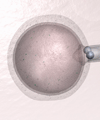January
Two and a half thousand women could benefit from mitochondrial donation in the UK

Almost 2,500 women of child-bearing age in the UK are at risk of transmitting mitochondrial disease to their children, according to the most recent estimates published today in the New England Journal of Medicine.
The research offers the most recent evidence yet of how many families could potentially be helped by new IVF techniques to prevent mitochondrial disease, which would be permitted by new regulations on which a vote in parliament is imminent.
Mitochondrial diseases are caused by inherited mutations in the DNA contained in mitochondria – tiny structures present in every cell that generate energy. Mitochondrial diseases can be devastating and particularly affect tissues that have high energy demands – brain, muscle (including heart), liver and kidney.
New IVF-based techniques have been developed which have the potential to prevent the transmission of serious mitochondrial disease. Known as ‘mitochondrial donation’ the techniques involve removing faulty mitochondria inherited from the mother and replacing them with the healthy mitochondria of another woman. The nuclear DNA, containing 99.9% of genetic material from the mother and father, remains unchanged.
Researchers at the Wellcome Trust Centre for Mitochondrial Research at Newcastle University, which will be the first to offer mitochondrial donation if parliament agrees to new regulations of the Human Fertilisation and Embryology Act (1990), have now calculated how many women have disease-causing mutations in their mitochondrial DNA in order to estimate how many could potentially benefit. The new regulations only allow for mitochondrial donation to prevent mitochondrial disease and set no precedent for genetic manipulation of nuclear DNA.
They calculate that 2,473 women in the UK, and 12,423 women in the US, aged between 15 and 44 years, are at risk of passing on potentially lethal mitochondrial DNA disease to their children. This equates to an average of 152 births per year in the UK, and 778 births per year in the US.
The estimates were made by identifying the number of women in North East England who are at risk of passing on mitochondrial disease to their children and extrapolating the figure to the rest of the UK, based on the relative number of women of child-bearing age in the North East compared to the UK as a whole. A similar method was used for the US figures. The study did not account for variance due to ethnicity or potentially different fertility rates in different parts of the UK.
Researchers also assessed the fertility of women with mitochondrial DNA mutations. To do this they compared fertility data from their patients’ to data about the general population, obtained from the UK Office for National Statistics. They found that mitochondrial mutation has no statistically significant effect on fertility rate.
Dr Gráinne Gorman from the Wellcome Trust Centre for Mitochondrial Research at Newcastle University, and joint first author of the paper, said: “Our estimate of how many women could benefit from mitochondrial donation is based on our data from North East England, where we have very detailed insight into how many women are affected. We are confident that there are a similar number of women across the UK at risk of passing on mitochondrial disease to their children.”
Professor Doug Turnbull, Director of the Wellcome Trust Centre for Mitochondrial Research at Newcastle University, and an author of the paper, said: “Our findings have considerable implications for all countries that are considering allowing mitochondrial donation techniques. In the UK we are waiting for parliament to decide whether to support these regulations. This would allow women who carry these mutations greater reproductive choice. ”
The research into mitochondrial donation has been possible, in large part, thanks to the women who have donated their eggs. But researchers still need more donors to come forward to enable work to continue. Professor Mary Herbert of Newcastle University and Scientific Director at Newcastle Fertility Centre at Life said: “Progress towards using the new techniques to prevent mitochondrial disease is entirely dependent on a supply of donated eggs. We would like to express our gratitude to all the women who have already donated eggs to the project and are very keen to encourage others who may be interested to go to www.ncl.ac.uk/eggdonate “
Reference
Gorman GS, Grady JP, Turnbull DM Mitochondrial Donation — How Many Women Could Benefit? N Engl J Med. 10.1056/NEJMc1500960
published on: 28 January 2015
